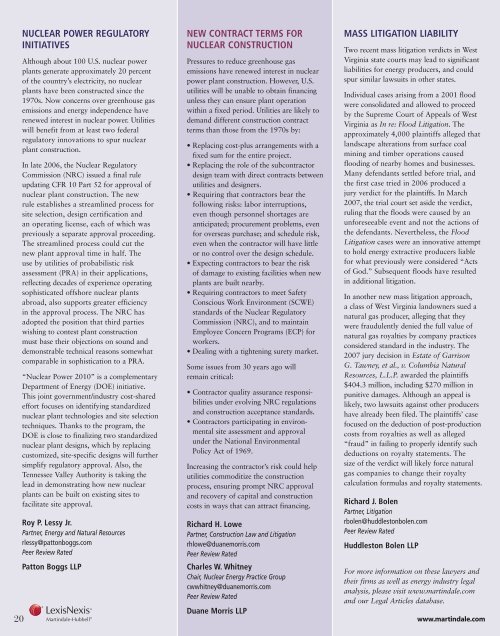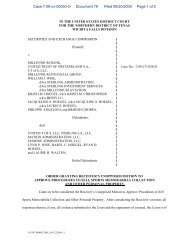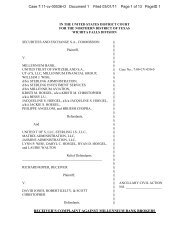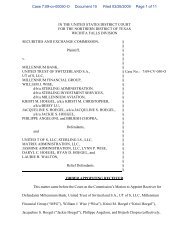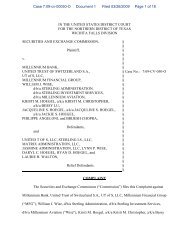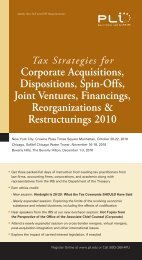View the full text of this document - Martindale.com
View the full text of this document - Martindale.com
View the full text of this document - Martindale.com
Create successful ePaper yourself
Turn your PDF publications into a flip-book with our unique Google optimized e-Paper software.
NUCLEAR POWER REGULATORY<br />
INITIATIVES<br />
Although about 100 U.S. nuclear power<br />
plants generate approximately 20 percent<br />
<strong>of</strong> <strong>the</strong> country’s electricity, no nuclear<br />
plants have been constructed since <strong>the</strong><br />
1970s. Now concerns over greenhouse gas<br />
emissions and energy independence have<br />
renewed interest in nuclear power. Utilities<br />
will benefit from at least two federal<br />
regulatory innovations to spur nuclear<br />
plant construction.<br />
In late 2006, <strong>the</strong> Nuclear Regulatory<br />
Commission (NRC) issued a final rule<br />
updating CFR 10 Part 52 for approval <strong>of</strong><br />
nuclear plant construction. The new<br />
rule establishes a streamlined process for<br />
site selection, design certification and<br />
an operating license, each <strong>of</strong> which was<br />
previously a separate approval proceeding.<br />
The streamlined process could cut <strong>the</strong><br />
new plant approval time in half. The<br />
use by utilities <strong>of</strong> probabilistic risk<br />
assessment (PRA) in <strong>the</strong>ir applications,<br />
reflecting decades <strong>of</strong> experience operating<br />
sophisticated <strong>of</strong>fshore nuclear plants<br />
abroad, also supports greater efficiency<br />
in <strong>the</strong> approval process. The NRC has<br />
adopted <strong>the</strong> position that third parties<br />
wishing to contest plant construction<br />
must base <strong>the</strong>ir objections on sound and<br />
demonstrable technical reasons somewhat<br />
<strong>com</strong>parable in sophistication to a PRA.<br />
“Nuclear Power 2010” is a <strong>com</strong>plementary<br />
Department <strong>of</strong> Energy (DOE) initiative.<br />
This joint government/industry cost-shared<br />
effort focuses on identifying standardized<br />
nuclear plant technologies and site selection<br />
techniques. Thanks to <strong>the</strong> program, <strong>the</strong><br />
DOE is close to finalizing two standardized<br />
nuclear plant designs, which by replacing<br />
customized, site-specific designs will fur<strong>the</strong>r<br />
simplify regulatory approval. Also, <strong>the</strong><br />
Tennessee Valley Authority is taking <strong>the</strong><br />
lead in demonstrating how new nuclear<br />
plants can be built on existing sites to<br />
facilitate site approval.<br />
Roy P. Lessy Jr.<br />
Partner, Energy and Natural Resources<br />
rlessy@pattonboggs.<strong>com</strong><br />
Peer Review Rated<br />
Patton Boggs LLP<br />
NEW CONTRACT TERMS FOR<br />
NUCLEAR CONSTRUCTION<br />
Pressures to reduce greenhouse gas<br />
emissions have renewed interest in nuclear<br />
power plant construction. However, U.S.<br />
utilities will be unable to obtain financing<br />
unless <strong>the</strong>y can ensure plant operation<br />
within a fixed period. Utilities are likely to<br />
demand different construction contract<br />
terms than those from <strong>the</strong> 1970s by:<br />
• Replacing cost-plus arrangements with a<br />
fixed sum for <strong>the</strong> entire project.<br />
• Replacing <strong>the</strong> role <strong>of</strong> <strong>the</strong> subcontractor<br />
design team with direct contracts between<br />
utilities and designers.<br />
• Requiring that contractors bear <strong>the</strong><br />
following risks: labor interruptions,<br />
even though personnel shortages are<br />
anticipated; procurement problems, even<br />
for overseas purchase; and schedule risk,<br />
even when <strong>the</strong> contractor will have little<br />
or no control over <strong>the</strong> design schedule.<br />
• Expecting contractors to bear <strong>the</strong> risk<br />
<strong>of</strong> damage to existing facilities when new<br />
plants are built nearby.<br />
• Requiring contractors to meet Safety<br />
Conscious Work Environment (SCWE)<br />
standards <strong>of</strong> <strong>the</strong> Nuclear Regulatory<br />
Commission (NRC), and to maintain<br />
Employee Concern Programs (ECP) for<br />
workers.<br />
• Dealing with a tightening surety market.<br />
Some issues from 30 years ago will<br />
remain critical:<br />
• Contractor quality assurance responsibilities<br />
under evolving NRC regulations<br />
and construction acceptance standards.<br />
• Contractors participating in environmental<br />
site assessment and approval<br />
under <strong>the</strong> National Environmental<br />
Policy Act <strong>of</strong> 1969.<br />
Increasing <strong>the</strong> contractor’s risk could help<br />
utilities <strong>com</strong>moditize <strong>the</strong> construction<br />
process, ensuring prompt NRC approval<br />
and recovery <strong>of</strong> capital and construction<br />
costs in ways that can attract financing.<br />
Richard H. Lowe<br />
Partner, Construction Law and Litigation<br />
rhlowe@duanemorris.<strong>com</strong><br />
Peer Review Rated<br />
Charles W. Whitney<br />
Chair, Nuclear Energy Practice Group<br />
cwwhitney@duanemorris.<strong>com</strong><br />
Peer Review Rated<br />
MASS LITIGATION LIABILITY<br />
Two recent mass litigation verdicts in West<br />
Virginia state courts may lead to significant<br />
liabilities for energy producers, and could<br />
spur similar lawsuits in o<strong>the</strong>r states.<br />
Individual cases arising from a 2001 flood<br />
were consolidated and allowed to proceed<br />
by <strong>the</strong> Supreme Court <strong>of</strong> Appeals <strong>of</strong> West<br />
Virginia as In re: Flood Litigation. The<br />
approximately 4,000 plaintiffs alleged that<br />
landscape alterations from surface coal<br />
mining and timber operations caused<br />
flooding <strong>of</strong> nearby homes and businesses.<br />
Many defendants settled before trial, and<br />
<strong>the</strong> first case tried in 2006 produced a<br />
jury verdict for <strong>the</strong> plaintiffs. In March<br />
2007, <strong>the</strong> trial court set aside <strong>the</strong> verdict,<br />
ruling that <strong>the</strong> floods were caused by an<br />
unforeseeable event and not <strong>the</strong> actions <strong>of</strong><br />
<strong>the</strong> defendants. Never<strong>the</strong>less, <strong>the</strong> Flood<br />
Litigation cases were an innovative attempt<br />
to hold energy extractive producers liable<br />
for what previously were considered “Acts<br />
<strong>of</strong> God.” Subsequent floods have resulted<br />
in additional litigation.<br />
In ano<strong>the</strong>r new mass litigation approach,<br />
a class <strong>of</strong> West Virginia landowners sued a<br />
natural gas producer, alleging that <strong>the</strong>y<br />
were fraudulently denied <strong>the</strong> <strong>full</strong> value <strong>of</strong><br />
natural gas royalties by <strong>com</strong>pany practices<br />
considered standard in <strong>the</strong> industry. The<br />
2007 jury decision in Estate <strong>of</strong> Garrison<br />
G. Tawney, et al., v. Columbia Natural<br />
Resources, L.L.P. awarded <strong>the</strong> plaintiffs<br />
$404.3 million, including $270 million in<br />
punitive damages. Although an appeal is<br />
likely, two lawsuits against o<strong>the</strong>r producers<br />
have already been filed. The plaintiffs’ case<br />
focused on <strong>the</strong> deduction <strong>of</strong> post-production<br />
costs from royalties as well as alleged<br />
“fraud” in failing to properly identify such<br />
deductions on royalty statements. The<br />
size <strong>of</strong> <strong>the</strong> verdict will likely force natural<br />
gas <strong>com</strong>panies to change <strong>the</strong>ir royalty<br />
calculation formulas and royalty statements.<br />
Richard J. Bolen<br />
Partner, Litigation<br />
rbolen@huddlestonbolen.<strong>com</strong><br />
Peer Review Rated<br />
Huddleston Bolen LLP<br />
For more information on <strong>the</strong>se lawyers and<br />
<strong>the</strong>ir firms as well as energy industry legal<br />
analysis, please visit www.martindale.<strong>com</strong><br />
and our Legal Articles database.<br />
Duane Morris LLP<br />
20 www.martindale.<strong>com</strong>


